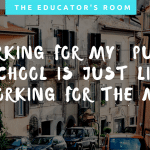In the U.S., one student drops out of school every 12 seconds.
Too often we assume that students drop out because they are disinterested or lazy. Maybe we should be looking at our traditional high schools to see if they may be the problem.
One model program that has been working since 1995 is Big Picture Learning. BPL was started in 1995 by Dennis Littky and Elliot Washor in Rhode Island. Both men had taught and been principals in public high schools. In 1995 they decided to make a change in how education and learning looked. Coincidentally, Rhode Island was looking at its educational system especially their vocational and technical programs. With the support of the community, BPL proposed a high school plan that would look very different than the traditional model. In 1996 the first Big Picture School (Metropolitan Regional Career and Technical Center) opened in Providence, Rhode Island. The first class started with 50 at risk students, most of whom were African American and Latino. These students would be educated in a very different facility and in a very different way than the traditional high school model.
The Program
1. Learning in the Real World (LTI)
Students work with mentors in the real world investigating subjects that interest them. The student will complete an authentic project that will benefit them as well as the mentor. This internship allows students to see how the world of work functions first hand. It also provides them with additional adult role models.
2. One student at a time (Personalization)
Students have their own individual learning plans which are updated quarterly. Parents, advisors and when possible mentors take part in these plans.
3. Authentic Assessment
Students complete exhibitions, portfolios, and journals are some of the assessments used. No grades are given but Big Picture has developed a system that can be used to translate these authentic assessments into a format that colleges will accept.
4. School Organization
Big Picture schools are small with advisories (ideally no more than 15 students). The principal and teachers are in constant communication with each other and the students. The community is used as a resource.
5. Advisory Structure
Advisories are small and stay with one advisor for their entire time in high school. This allows the advisor to mentor students, as well as get to really know them as individuals. The advisor not only supports students but facilitates an atmosphere in which the students support each other.
The Met now has 6 small high schools grouped together on an open campus. Parents and community members are encouraged to visit and support the students. The first class mentioned above graduated in 2000 with a 96 % graduation rate. In addition, 98% of these graduates were admitted to post secondary institutions. The Bill and Melinda Gates Foundation has granted Big Picture several grants in support of their work to improve education.
For many, Big Picture Learning may sound like a very radical departure from what we normally think of as high school education. Considering that there are now at least 60 Big Picture schools across the United States and a number of international schools in places like the Netherlands, Israel and Australia, the Big Picture model might be one to consider for those who don’t succeed in a traditional high school.
For more information please check the Big Picture website.




